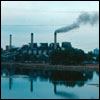With high Comprehensive Environmental Pollution Index scores, several industrial clusters of Gujarat have been figuring in the list of the country’s critically polluted areas, but the state government’s lackadaisical attitude and refusal to engage in any debate on the issue has now drawn the ire of environmentalists.
Industrial clusters with CEPI score of 70 and above are considered critically polluted while those with CEPI score between 60 and 70 are identified as severely polluted.
According to well-known Vadodara-based environmental activist Rohit Prajapati, the fact that Gujarat topped the list of the country’s critically polluted areas during 2009 and maintained its position in 2011 and 2013 is never commented upon by Gujarat Chief Minister Narendra Modi in his speeches.
 “Mr. Narendra Modi in his book ‘Convenient Action: Gujarat’s Response to Challenges of Climate Change’ published in 2011, on page 132-133, has printed a photograph of Vapi’s Common Effluent Treatment Plant which even today does not operate as per the prescribed norms of Gujarat Pollution Control Board ,” Prajapati said in a recent press statement.
“Mr. Narendra Modi in his book ‘Convenient Action: Gujarat’s Response to Challenges of Climate Change’ published in 2011, on page 132-133, has printed a photograph of Vapi’s Common Effluent Treatment Plant which even today does not operate as per the prescribed norms of Gujarat Pollution Control Board ,” Prajapati said in a recent press statement.
“When the CETP of Vapi industrial area is not able to meet the prescribed GPCB norms, what message does the CM want to convey to the country and the world by printing a two page photograph of this treatment plant? On this issue we have posed several questions to him in our review of his book but he has been unable to answer a single question,” he added.
In 2009, the industrial cluster/area of Ankleshwar topped the list of critically polluted areas with CEPI score of 88.50. In 2011 and 2013, the industrial cluster/area of Vapi was at the top of the list with CEPI score of 85.31.
Prajapati alleged that in case of some industrial clusters/areas in the state, the powerful industrial lobby in collusion with politicians and the official machinery had at different times managed to get the moratorium imposed at the direction of Central Pollution Control Board on setting up new industries and/or increasing the production capacity of existing industries lifted surreptitiously.
“The industries located in Ankleshwar, Panoli and Jhagadia Gujarat Industrial Development Corporation estates treat their effluent in their CETP and then after giving further treatment at the Final Effluent Treatment Plant at Ankleshwar discharge the effluent into the sea,” said Prajapati.
“The FETP, from its inception, did not work as per the prescribed norms set by the GPCB. Even today it is not able to meet the prescribed norm. For this reason, on July 7, 2007, GPCB, on the directions of the CPCB, imposed a moratorium on the industrial areas of Ankleshwar, Panoli and Jhagadia. The moratorium is in force even today, since there has been no substantial improvement in the pollution levels even after the implementation of the so called ‘action plans’ prepared by these estates,” he added.
Prajapati opined that support to the CETPs through public funding went against the principle that required the polluter to pay. He said that out of the total cost of a CETP, 25 percent was state subsidy, 25 percent central subsidy, 30 percent loan from financial institutions and only 20 percent directly paid by industries.
“The pipe line project of FETP of Ankleshwar was built with the sweat of tax payers. Out of a total project cost of Rs.131.43 crore, the industries paid only Rs. 21.75 crore (about 17 percent). The rest of the tab (Rs.109 crore) was borne by the Central Government, the Gujarat government, and the GIDC, all of which ultimately draw from public money,” he said.
Prajapati called for strict action against the industries flouting environmental norms in the state. He said that despite the GPCB serving repeated closure notices on several violating industries, the affected industrial clusters/areas have witnessed little change, as revealed by the CPCB report of April 2013.











